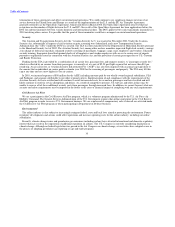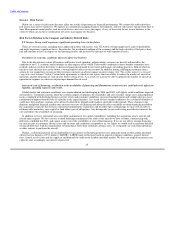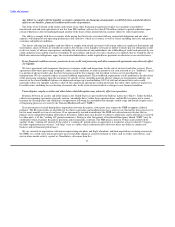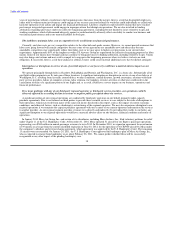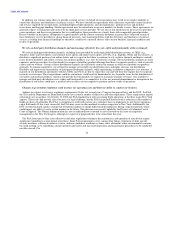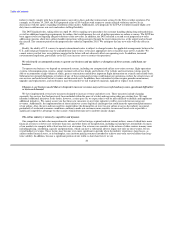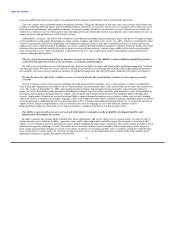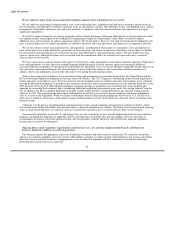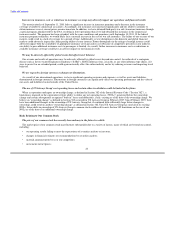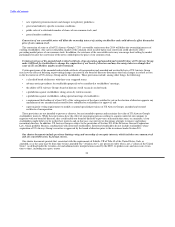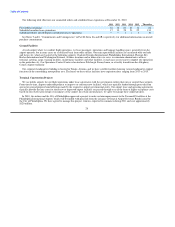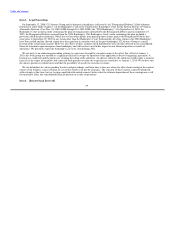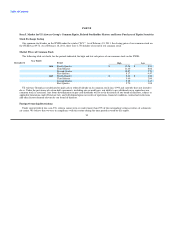US Airways 2010 Annual Report Download - page 21
Download and view the complete annual report
Please find page 21 of the 2010 US Airways annual report below. You can navigate through the pages in the report by either clicking on the pages listed below, or by using the keyword search tool below to find specific information within the annual report.
Table of Contents
failure to timely comply with these requirements can result in fines and other enforcement actions by the FAA or other regulators. For
example, on October 14, 2009, the FAA proposed a fine of $5.4 million with respect to certain alleged violations and we are in
discussions with the agency regarding resolution of this matter. Additionally, new proposals by the FAA to further regulate flight crew
duty times could increase our costs and reduce staffing flexibility.
The DOT finalized rules, taking effect on April 29, 2010, requiring new procedures for customer handling during long onboard delays,
as well as additional reporting requirements for airlines that could increase the cost of airline operations or reduce revenues. The DOT has
been aggressively investigating alleged violations of the new rules. In addition, the DOT released a second set of proposed new rules
addressing concerns about how airlines handle interactions with passengers through the reservations process, at the airport and on board
the aircraft. The comment period on the proposed rules ended in September 2010. We anticipate that any new rules will take effect in
2011.
Finally, the ability of U.S. carriers to operate international routes is subject to change because the applicable arrangements between the
U.S. and foreign governments may be amended from time to time, or because appropriate slots or facilities may not be available. We
cannot assure you that laws or regulations enacted in the future will not adversely affect our operating costs. In addition, increased
environmental regulation, particularly in the EU, may increase costs or restrict our operations.
We rely heavily on automated systems to operate our business and any failure or disruption of these systems could harm our
business.
To operate our business, we depend on automated systems, including our computerized airline reservation systems, flight operations
systems, telecommunication systems, airport customer self-service kiosks and websites. Our website and reservation systems must be
able to accommodate a high volume of traffic, process transactions and deliver important flight information on a timely and reliable basis.
Substantial or repeated disruptions or failures of any of these automated systems could impair our operations, reduce the attractiveness of
our services and could result in lost revenues and increased costs. In addition, these automated systems require periodic maintenance,
upgrades and replacements, and our business may be harmed if we fail to properly maintain, upgrade or replace such systems.
Changes to our business model that are designed to increase revenues may not be successful and may cause operational difficulties
or decreased demand.
We have implemented several new measures designed to increase revenue and offset costs. These measures include charging
separately for services that had previously been included within the price of a ticket and increasing other pre-existing fees. We may
introduce additional initiatives in the future, however, as time goes on, we expect that it will be more difficult to identify and implement
additional initiatives. We cannot assure you that these new measures or any future initiatives will be successful in increasing our
revenues. Additionally, the implementation of these initiatives creates logistical challenges that could harm the operational performance
of our airline. Also, the new and increased fees might reduce the demand for air travel on our airline or across the industry in general,
particularly if weakened economic conditions continue to make our customers more sensitive to increased travel costs or provide a
significant competitive advantage to other carriers which determine not to institute similar charges.
The airline industry is intensely competitive and dynamic.
Our competitors include other major domestic airlines as well as foreign, regional and new entrant airlines, some of which have more
financial resources or lower cost structures than ours, and other forms of transportation, including rail and private automobiles. In many
of our markets we compete with at least one low cost air carrier. Our revenues are sensitive to the actions of other carriers in many areas
including pricing, scheduling, capacity and promotions, which can have a substantial adverse impact not only on our revenues, but on
overall industry revenues. These factors may become even more significant in periods when the industry experiences large losses, as
airlines under financial stress, or in bankruptcy, may institute pricing structures intended to achieve near-term survival rather than long-
term viability. In addition, because a significant portion of our traffic is short-haul travel, we are
20


